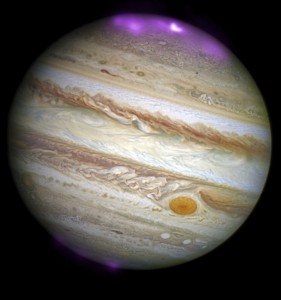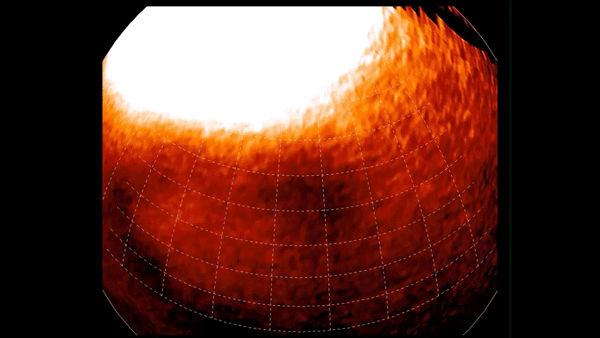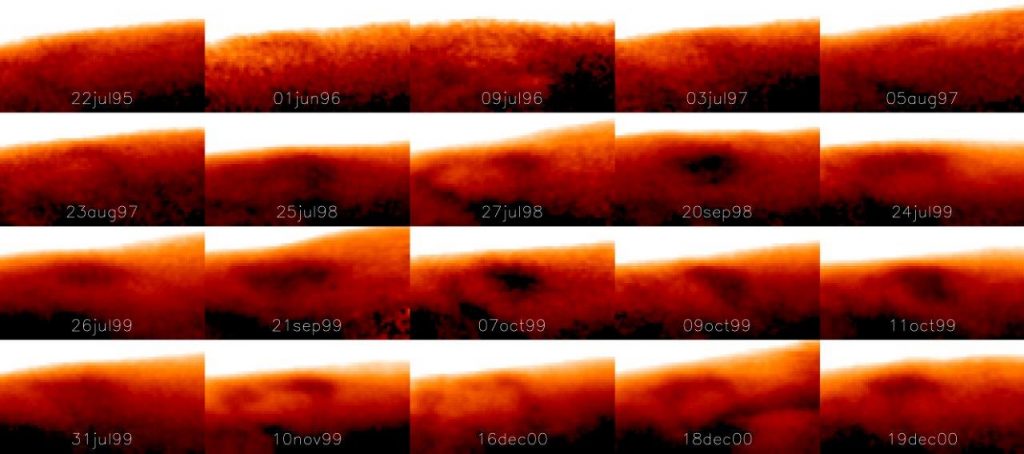Massive aurorae-generated weather system revealed by astronomers
11 April 2017

A second Great Spot has been discovered on Jupiter by astronomers, rivaling the scale of the planet’s famous Great Red Spot and created by the powerful energies exerted by the great planet’s polar aurorae. Credit: Joseph DePasquale, Smithsonian Astrophysical Observatory Chandra X-ray Center.
WASHINGTON, DC— A second Great Spot has been discovered on Jupiter by astronomers, rivaling the scale of the planet’s famous Great Red Spot and created by the powerful energies exerted by the great planet’s polar aurorae.
Dubbed the ‘Great Cold Spot’, it has been observed as a localized dark spot, up to 24,000 kilometers in longitude and 12,000 kilometers in latitude, in the gas giant’s thin high-altitude thermosphere, that is around 200 degrees Kelvin cooler than the surrounding atmosphere, which can range in temperature between 700 degrees Kelvin (426 degrees Celsius) and 1000 degrees Kelvin (726 degrees Celsius).
The results are published today in Geophysical Research Letters, a journal of the American Geophysical Union.
“This is the first time any weather feature in Jupiter’s upper atmosphere has been observed away from the planet’s bright aurorae,” said Tom Stallard, Associate Professor in Planetary Astronomy at the University of Leicester in the United Kingdom, and lead author of the new study.
“The Great Cold Spot is much more volatile than the slowly changing Great Red Spot, changing dramatically in shape and size over only a few days and weeks, but it has re-appeared for as long as we have data to search for it, for over 15 years,” Stallard said. “That suggests that it continually reforms itself, and as a result it might be as old as the aurorae that form it – perhaps many thousands of years old.”
The Great Cold Spot is thought to be caused by the effects of the magnetic field of the planet, with the massive planet’s spectacular polar aurorae driving energy into the atmosphere in the form of heat flowing around the planet.

This is a computerized view of the Great Cold Spot seen as it would appear from directly above by a satellite in orbit around Jupiter at a distance of 35,000 km above the planet (half the radius of Jupiter). This view shows how the Great Cold Spot changed between 1998-2000, with dramatically different shapes in this period. The original images used to construct this animation were made by the NSFCam instrument on NASA’s IRTF telescope in Hawaii. Credit: Tom Stallard.
This creates a region of cooling in the thermosphere, the boundary layer between the underlying atmosphere and the vacuum of space. Although we can’t be sure what drives this weather feature, a sustained cooling is very likely to drive a vortex similar to the Great Red Spot.
The astronomers used the CRIRES instrument on the Very Large Telescope (VLT) to observe spectral emissions of H3+, an ion of hydrogen present in large amounts in Jupiter’s atmosphere, which allowed the scientists to map the mean temperature and density of the planet’s atmosphere. They then used images of H3+ emission from Jupiter’s ionosphere taken by NASA’s InfraRed Telescope Facility between 1995-2000 to compare.
Through combining images taken over a period of time, including over 13,000 images taken over more than 40 nights by the InfraRed Telescope Facility, the astronomers revealed the presence of the Great Cold Spot as an area of darkness amongst the hot environment of Jupiter’s upper atmosphere.

This image shows how the Great Cold Spot changes dramatically in shape and size on different days. Each view comes from a different day, with the spot sometimes almost disappearing. Because the feature is dynamic, changing over both daily and yearly timescales, it is likely that this feature is a weather system that is in a constant state of change. But despite this variability, it is seen again fifteen years later, showing it must reform again and again. Credit: Tom Stallard.
Stallard, who is funded by the Science and Technology Facilities Council, added: “What is surprising at Jupiter is that, unlike weather systems on Earth, the Great Cold Spot has been observed at the same place across 15 years. That makes it more comparable to weather systems in Jupiter’s lower atmosphere, like the Great Red Spot.
“Observations and modelling of Earth’s upper atmosphere have shown that, on the short term, there may be changes in the temperature and density of the upper atmosphere.
“The two main differences are firstly that Earth’s aurora sees dramatic changes caused by activity from the Sun, whereas Jupiter’s aurora are dominated by gases from the volcanic moon Io, which are relatively slow and steady, and secondly that the atmospheric flows generated by Earth’s aurora can drive heat quickly across the whole planet, making the upper atmosphere ring like a bell, while Jupiter’s fast spin traps this energy nearer the poles.”

Once the Great Cold Spot was detected, the researchers searched for it in past observations. Jupiter’s infrared aurora was studied in detail by the NSFCam instrument on NASA’s InfraRed Telescope Facility (IRTF) for six year between 1995-2000, in preparation for the last mission to visit Jupiter, Galileo. These extensive observations resulted in a huge set of images of Jupiter, with more than 13,000 images taken over more than 40 nights. The video shown here, taken on the 19 December 2000, shows how Jupiter’s aurora is offset from the magnetic pole, so that it rotates into and out of view. The faint emission away from the aurora hides the Great Cold Spot. Credit: Tom Stallard.
Stallard added: “The detection of the Great Cold Spot was a real surprise to us, but there are indications that other features might also exist in Jupiter’s upper atmosphere. Our next step will be to look for other features in the upper atmosphere, as well as investigating the Great Cold Spot itself in more detail.
“The Juno spacecraft is currently in orbit around Jupiter and the observations of Jupiter’s aurora and upper atmosphere by the JIRAM instrument that have been released so far already provide a wealth of new information about the planet. When combined with our ongoing campaign of observations using telescopes on Earth, we hope to gain a much better understanding of this weather system in the next few years.”
###
The American Geophysical Union is dedicated to advancing the Earth and space sciences for the benefit of humanity through its scholarly publications, conferences, and outreach programs. AGU is a not-for-profit, professional, scientific organization representing 60,000 members in 137 countries. Join the conversation on Facebook, Twitter, YouTube, and our other social media channels.
The Science and Technology Facilities Council is keeping the UK at the forefront of international science and tackling some of the most significant challenges facing society such as meeting our future energy needs, monitoring and understanding climate change, and global security. The Council has a broad science portfolio including supporting UK work in space and ground-based astronomy technologies and research. http://www.stfc.ac.uk/
The University of Leicester is led by discovery and innovation – an international centre for excellence renowned for research, teaching and broadening access to higher education. The University of Leicester is ranked among the top one per cent of universities in the world by the THE World University Rankings. It is among the top 25 universities in the Times Higher Education REF Research Power rankings with 75% of research adjudged to be internationally excellent with wide-ranging impacts on society, health, culture, and the environment. Find out more: http://le.ac.uk/about-us.
Notes for Journalists
This research article is open access for 30 days. A PDF copy of the article can be downloaded at the following link: http://onlinelibrary.wiley.com/doi/10.1002/2016GL071956/pdf.
After 30 days, journalists and public information officers (PIOs) of educational and scientific institutions who have registered with AGU can download a PDF copy of the article from the same link.
Journalists and PIOs may also order a copy of the final paper by emailing a request to Lauren Lipuma at [email protected]. Please provide your name, the name of your publication, and your phone number.
Neither the paper nor this press release is under embargo.
“The Great Cold Spot in Jupiter’s upper atmosphere”
Authors:
Tom S. Stallard: Department of Physics and Astronomy, University of Leicester, Leicester, U.K.;
Henrik Melin: Department of Physics and Astronomy, University of Leicester, Leicester, U.K.;
Steve Miller: Department of Physics and Astronomy, University College London, London, U.K.;
Luke Moore: Center for Space Physics, Boston University, Boston, MA, USA;
James O’Donoghue: Center for Space Physics, Boston University, Boston, MA, USA;
John E. P. Connerney: Goddard Space Flight Center, NASA, Greenbelt, MD, USA;
Takehiko Satoh: Institute of Space and Astronautical Science, JAXA, Japan;
Robert A. West: Jet Propulsion Laboratory, California Institute of Technology, Pasadena, CA, USA;
Jeffrey P Thayer: Aerospace Engineering Sciences, University of Colorado at Boulder, Boulder, CO, USA;
Vicki W. Hsu: Aerospace Engineering Sciences, University of Colorado at Boulder, Boulder, CO, USA;
Rosie E. Johnson: Department of Physics and Astronomy, University of Leicester, Leicester, U.K.
Contact information for the authors:
Tom Stallard: 0116 252 3589, 07941 964 864 (cell); [email protected]
Lauren Lipuma
+1 (202) 777-7396
[email protected]
University of Leicester Press Contact:
Peter Thorley
0116 252 2415
[email protected]